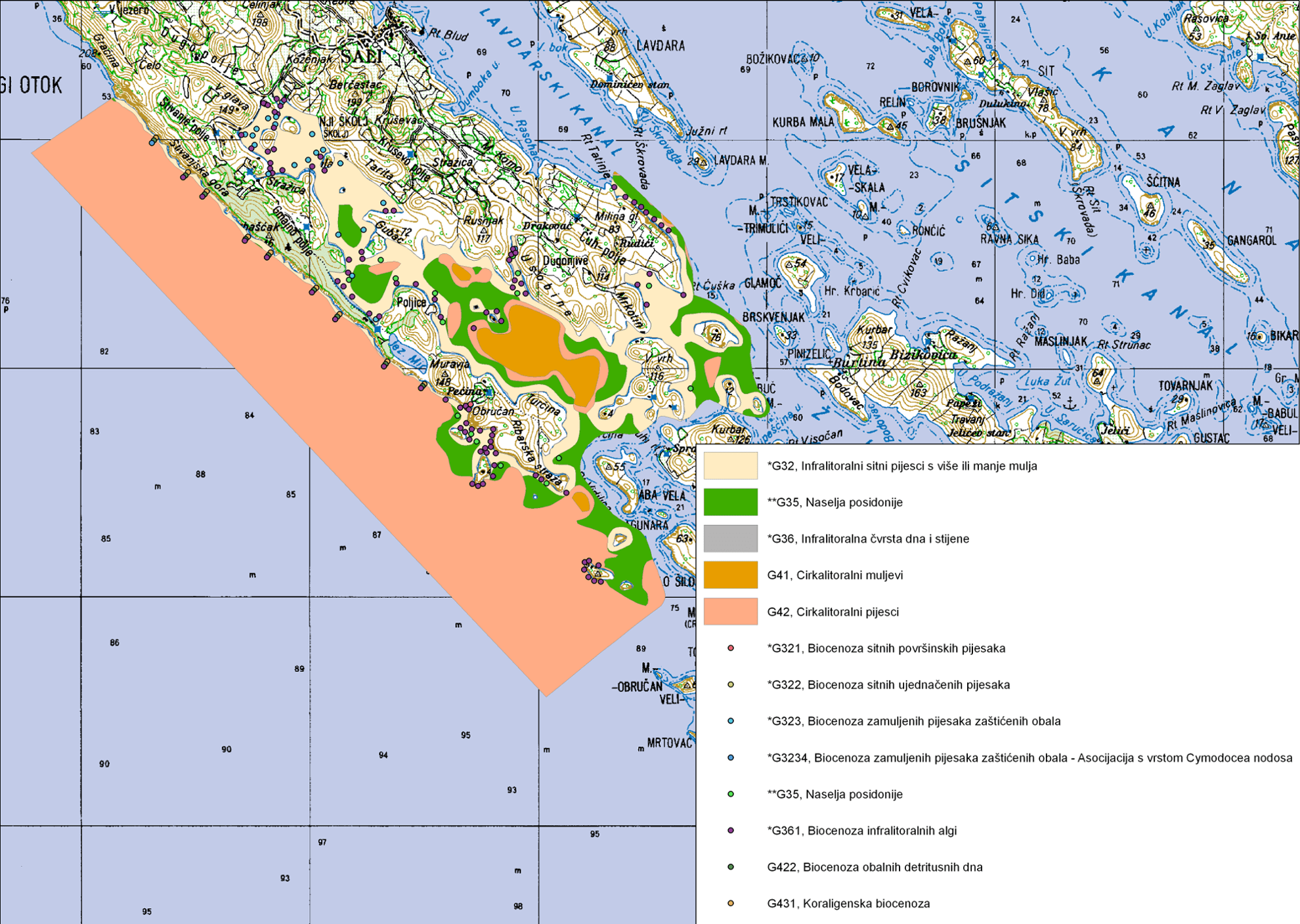

Marine habitats
According to the National Classification of Habitats, there are 14 types of marine habitats in the Nature Park.
Types of marine habitats in the area of Nature Park Telašćica
| NCH designation | Type of habitat |
|---|---|
| F. | SEA COAST |
| F.1. | Muddy sea coast |
| F.1.2. | Supralittoral muds# |
| F.2. | Supralittoral muds |
| F.2.2. | Supralittoral sands# |
| F.2.2.1. | Biocenosis of supralittoral sands |
| F.4. | Rocky sea coast |
| F.4.2. | Supralittoral rocks# |
| F.4.2.1. | Biocenosis of supralittoral rocks |
| G. | SEA |
| G.2. | Mediolittoral |
| G.2.1. | Mediolittoral muddy sands and muds# |
| G.2.1.1. | Biocenosis of mediolittoral muddy sands and muds |
| G.2.2. | Mediolittoral sands# |
| G.2.2.1. | Biocenosis of mediolittoral sands |
| G.2.3. | Mediolittoral gravel and stones |
| G.2.4. | Mediolittoral hard seabeds and rocks#* |
| G.2.4.1. | Biocenosis of upper rocks of mediolittoral |
| G.2.4.2. | Biocenosis of bottom rocks of mediolittoral |
| G.2.4.3. | Biocenosis of mediolittoral caves |
| G.2.4.4. | Mediolittoral community of karst sea lakes |
| G.3. | Infralittoral |
| G.3.1. | Infralittoral sandy muds, sands, gravels and stones in euryhaline and eurithermal environment#* |
| G.3.1.1. | Euryhaline and eurithermal biocenosis |
| G.3.1.1.4. | Association with Zostera noltii in euryhaline and eurithermal environment |
| G.3.2. | Infralittoral sands with more or less mud# |
| G.3.2.1 | Biocenosis of fine sands in very shallow waters |
| G.3.2.1.1. | Facies with Lentidium mediterraneum |
| G.3.2.2. | Biocenosis of well sorted fine sands |
| G.3.2.2.1. | Association with Cymodocea nodosa |
| G.3.2.3. | Biocenosis of superficial muddy sands in sheltered waters |
| G.3.2.3.3. | Facies with Loripes lacteus and Tapes spp. |
| G.3.2.3.4. | Association with Cymodocea nodosa |
| G.3.2.3.5. | Association with Zostera noltii |
| G.3.3. | Infralittoral coarse sands with more or less mud# |
| G.3.3.1. | Biocenosis of coarse sands and fine gravels mixed by the waves |
| G.3.3.2. | Biocenosis of coarse sands and fine gravels under the influence of bottom currents (also found in the Circalittoral) |
| G.3.4. | Infralittoral stones and pebbles# |
| G.3.4.1. | Biocenosis of infralittoral pebbles |
| G.3.5. | Posidonia oceanica meadows#* |
| G.3.5.1. | Biocenosis of Posidonia oceanica meadows |
| G.3.6. | Infralittoral hard beds and rocks# |
| G.3.6.1. | Biocenosis of infralittoral algae |
| G.3.7. | Infralittoral of karst sea lakes#* |
| G.3.7.1. | Infralittoral communities of karst sea lakes |
| G.4. | Circalittoral |
| G.4.1. | Circalittoral muds# |
| G.4.1.2. | Biocenosis of muddy bottoms of the open Adriatic and the northern Adriatic channel |
| G.4.2. | Circalittoral sands# |
| G.4.2.1. | Biocenosis of the muddy detritic bottom |
| G.4.2.2. | Biocenosis of the coastal detritic bottom |
| G.4.3. | Circalittoral hard beds and rocks# |
| G.4.3.1. | Coralligenous biocenosis |
| G.4.3.2. | Biocenosis of semi-dark caves (also in enclave in upper stages) |
| G.4.4. | Circalittoral of karst sea lakes#* |
| G.4.4.1. | Circalittoral communities of karst sea lakes |
| G.5. | Bathyal |
| G.5.3. | Bathyal hard seabeds and rocks# |
| G.5.3.2. | Biocenosis of caves and ducts in total darkness (in enclave in the upper stages) |
#– endangered and rare habitat types according to the Ordinance on amendments to the Ordinance on kinds of habitat types, habitats map, threatened and rare habitat types and on measures for conservation of habitat types (Official Gazette “Narodne novine” 119/09). These habitats include all habitat types of the lower classification level.
*– priority habitats
An overview of benthic communities (Inventory of underwater biocenosis of Telašćica Bay, Bakran-Petricioli, 2003) was done in 2002 and 2003 in the area of the Nature Park, during which 19 from a total of 33 benthic communities that are believed to exist in the Adriatic were recorded. So far valuable results of the primary distribution of benthic biocenoses in the bay and the open-sea side of the Nature Park have been obtained through research, but more work on inventorying and mapping of benthic biocenoses needs to be done, and existing maps need to be updated accordingly.



